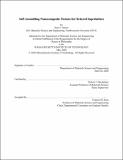| dc.contributor.advisor | Robert J. Macfarlane. | en_US |
| dc.contributor.author | Santos, Peter J.(Peter Jeffries) | en_US |
| dc.contributor.other | Massachusetts Institute of Technology. Department of Materials Science and Engineering. | en_US |
| dc.date.accessioned | 2020-10-08T21:29:49Z | |
| dc.date.available | 2020-10-08T21:29:49Z | |
| dc.date.copyright | 2020 | en_US |
| dc.date.issued | 2020 | en_US |
| dc.identifier.uri | https://hdl.handle.net/1721.1/127907 | |
| dc.description | Thesis: Ph. D., Massachusetts Institute of Technology, Department of Materials Science and Engineering, May, 2020 | en_US |
| dc.description | Cataloged from the official PDF of thesis. | en_US |
| dc.description | Includes bibliographical references (pages 260-280). | en_US |
| dc.description.abstract | Nanocomposites, materials of heterogeneous composition with at least one of the phases having dimensions between 1-100 nm, can be produced with unique properties dependent on their composition and geometric configuration. However, it is a major challenge to precisely and simultaneously design the structure of synthetic nanocomposites at the nanoscale, microscale, and macroscale. To create advanced nanocomposites in which both structure and composition can be programmed across these disparate size regimes, we have developed a new nanoparticle-based building block, the Nanocomposite Tecton (NCT). An NCT consists of an inorganic nanoparticle core and a polymeric shell, with each chain terminating in a supramolecular binding group at the periphery of the NCT. | en_US |
| dc.description.abstract | As each NCT contains both an inorganic nanoparticle and a polymer phase, each building block is itself a nanocomposite, and the incorporation of supramolecular binding groups allows for the directed assembly of NCTs that contain complementary binding groups. These reversible supramolecular interactions enable the assembly of NCTs into ordered arrays, and the collective behavior of the binding groups can be regulated by the dynamics of the polymer chains. The NCTs are capable of rapidly self-assembling into several different crystalline phases that are determined by the design of the building block, and are resilient against dispersity in the molecular weight of the polymer brush and the diameter of the nanoparticle cores. NCTs have been synthesized with both gold and iron oxide nanoparticle cores, indicating the ability to produce NCTs at reasonable scales. | en_US |
| dc.description.abstract | Moreover, the incorporation of multiple nanoparticle compositions allows for the synthesis of NCT-based materials with plasmonic and magnetic properties that can affect, as well as be affected by, the assembly process. We further demonstrate that the crystallization kinetics can be modulated to induce the assembly of NCTs into faceted crystallites with micron-sized diameters, and the resulting NCT crystallites can be post-processed into bulk solids with arbitrary macroscopic shape and controlled grain size. The NCT design concept is therefore a highly modular and versatile building block capable of fabricating materials with controlled structures at the levels of atomic composition and molecular geometry, nanoscale organization, microstructure, and macroscopic form. | en_US |
| dc.description.statementofresponsibility | by Peter J. Santos. | en_US |
| dc.format.extent | 280 pages | en_US |
| dc.language.iso | eng | en_US |
| dc.publisher | Massachusetts Institute of Technology | en_US |
| dc.rights | MIT theses may be protected by copyright. Please reuse MIT thesis content according to the MIT Libraries Permissions Policy, which is available through the URL provided. | en_US |
| dc.rights.uri | http://dspace.mit.edu/handle/1721.1/7582 | en_US |
| dc.subject | Materials Science and Engineering. | en_US |
| dc.title | Self-assembling nanocomposite Tectons for ordered superlattices | en_US |
| dc.type | Thesis | en_US |
| dc.description.degree | Ph. D. | en_US |
| dc.contributor.department | Massachusetts Institute of Technology. Department of Materials Science and Engineering | en_US |
| dc.identifier.oclc | 1197629047 | en_US |
| dc.description.collection | Ph.D. Massachusetts Institute of Technology, Department of Materials Science and Engineering | en_US |
| dspace.imported | 2020-10-08T21:29:47Z | en_US |
| mit.thesis.degree | Doctoral | en_US |
| mit.thesis.department | MatSci | en_US |
